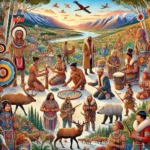In the rugged landscapes of southern Oregon and northern California, a historic transformation is underway. The Klamath River, once one of the most productive salmon rivers in the United States, is finally being given a chance to heal. The demolition of four hydroelectric dams—J.C. Boyle, Copco 1, Copco 2, and Iron Gate—marks the largest dam removal project in U.S. history. At the heart of this achievement lies the perseverance of Indigenous tribes, for whom the river is not just water, but identity, sustenance, and spirit.
A River Interrupted
For millennia, the Klamath River ran freely for over 250 miles, connecting the mountains to the Pacific Ocean. Every year, salmon made their epic journey upstream to spawn, sustaining not only ecosystems but also the lives of the people who lived along its banks.
That cycle was broken in the 20th century. Between 1918 and 1962, four major dams were constructed to generate hydroelectric power. These dams—while supplying electricity—cut off salmon from more than 400 miles of spawning habitat. Without fish ladders, the salmon simply could not pass. Populations collapsed.
By the early 2000s, the situation had become catastrophic. In 2002, more than 34,000 salmon died in a single season due to low water flows, high temperatures, and disease outbreaks—a disaster that devastated fishing communities and tribal nations.
Why Salmon Matter
Salmon are not just another fish species. They are keystone species: their life cycle transfers nutrients from the ocean to inland rivers, feeding bears, eagles, forests, and people. When salmon decline, entire ecosystems weaken.
For Indigenous peoples such as the Yurok, Karuk, Hoopa Valley, and Klamath Tribes, salmon are sacred. They are woven into ceremony, diet, and cultural identity. As Yurok Tribal Council member Joseph James once said:
“The Klamath salmon are our relatives. Bringing them home is bringing ourselves back to balance.”
(Source: Yurok Tribe press release, 2023)
Without salmon, these communities faced not only economic loss but cultural erasure.
Indigenous Leadership and Worldview
The fight to remove the dams was not led by corporations or government agencies at first—it was driven by Indigenous nations. For decades, tribal leaders organized protests, launched lawsuits, and built alliances with environmentalists, scientists, and fishing groups.
Their vision was grounded in a worldview that sees rivers and fish not as “resources” to be managed, but as relatives with rights to exist. This perspective challenged the dominant industrial logic of the 20th century, which treated rivers as tools for electricity and irrigation.
The Karuk Tribe, for example, framed dam removal as both ecological restoration and cultural survival. The Yurok Tribe invested its own resources in scientific research to prove the connection between dams, water quality, and salmon mortality. Over time, their persistence shifted public opinion and policy.
The Project: Largest Dam Removal in U.S. History
In 2016, a landmark agreement cleared the way for dam removal, supported by California, Oregon, tribal nations, and PacifiCorp (the utility that owned the dams). By 2023, demolition began.
Copco 2 was the first to fall in 2023.
Copco 1, J.C. Boyle, and Iron Gate followed, with deconstruction continuing through 2024–25.
Once complete, over 400 miles of river habitat will be reopened for salmon and other species. Sediment trapped for decades is being flushed downstream, reshaping channels and restoring natural flow.
Scientists expect salmon runs to rebound within a decade, though full recovery may take longer.
Climate and Ecological Significance
The Klamath project is more than local—it’s a global climate story. As climate change warms rivers and stresses ecosystems, removing barriers like dams becomes essential for resilience. Free-flowing rivers regulate temperatures better, support biodiversity, and adapt more flexibly to shifting rainfall patterns.
It also challenges a false dichotomy: that renewable energy like hydropower must always outweigh ecological costs. The Klamath shows that justice, culture, and climate adaptation can align when Indigenous voices are centered.
Looking Forward
The Klamath Dam removal is not just engineering—it is reconciliation. It acknowledges a century of harm done to rivers, salmon, and Indigenous peoples, and it attempts repair.
As the Yurok Tribe stated when demolition began:
“This is more than dam removal. It is healing—for the river, for the salmon, and for our people.”
The world is watching. If the salmon return, the Klamath will stand as a living symbol that climate action is not only about carbon and technology—it is about restoring relationships between humans and the living systems we depend on.
✨ In short: The Klamath story is a climate story, an Indigenous story, and a salmon story. It is proof that when communities fight for nature as kin, even the biggest concrete walls can come down.












